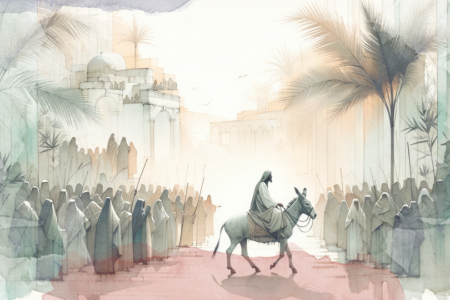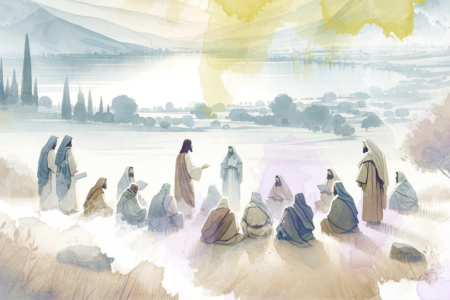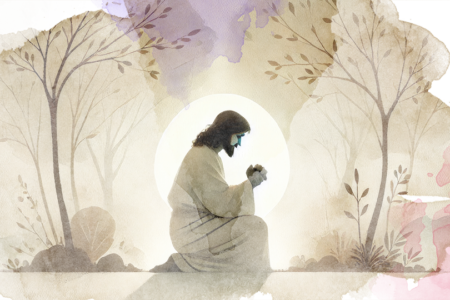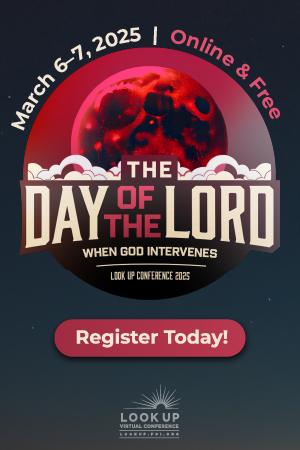The Ark of The Covenant: Christ Our Advocate Exodus 25:10-22, 37:1-9
In a spirit of reverence, we loose the shoes from off our feet, part the veil and enter onto the sacred ground of the holy of holies to gaze upon the small golden ark of the covenant. Just think of the privilege which is ours; a privilege to view the ark and to see its prophetic fulfillment in Christ. This privilege was unknown to the children of Israel except for two people: Moses, who could approach God at all times before the mercy seat (Ex. 25:22); and the high priest, who could enter but once a year to make atonement for his own sins and for those of the people. Come, let us enter with boldness as we have been instructed and glean the many lessons God has for us.
span class=”subhead”The Construction of the Ark
The ark was symbolic of God’s throne and presence making it the most sacred article of furniture in the tabernacle. In fact, the tabernacle was built to house the ark of the covenant so God could dwell among His people. It was the first item of furniture to be made after God had instructed Moses to build the tabernacle (see Ex. 25:8-10). It was on the top of the mercy seat, between the two cherubim, where God would place His glory (Ps. 80:1) in the form of a cloud by day and a pillar of fire by night (Ex. 40:34-38).
The ark was called by many names. It was known as the “ark of the testimony” (Ex. 25:22) because it was where the two tablets of the law were kept. It was called the “ark of the covenant” (Num. 10:33) speaking of God’s covenant relationship with His people. It was also called the “ark of God” (1 Sam. 3:3), “the ark of the Lord God” (1 Ki. 2:26), “the holy ark” (2 Chron. 35:3), and the “ark of thy strength” (Ps. 132:8).
The ark was a rectangular chest, three feet nine inches long and two feet three inches wide and high, made of acacia wood and covered with gold inside and out. It had a gold rim which encircled its top, gold rings on the four corners and staves of acacia wood covered with gold to carry it. The lid, called the mercy seat, was of pure gold. On top of the ark, at each end, stood two cherubim of gold facing each other but looking down towards the mercy seat with their wings touching each other as they were stretched out over its top (Ex. 25:10-20).
The ark is one of the clearest types of Jesus Christ presented in the Bible. As we have seen in the brazen altar, the table of showbread and the altar of incense, the acacia wood typifies our Lord’s life and ministry. It is a hard, incorruptible and indestructible wood which grows in the Sinai desert. It beautifully portrays the humanity of Christ who came from a “root out of a dry ground” (Isa. 53:2) and was absolutely sinless in His birth (Lk. 1:35) and life (1 Pet. 1:19; 2:22). Even His enemies recognized that He was sinless: Judas (Mt. 27:4); Pilate (Lk. 23:4, 14); Pilate’s wife (Mt. 27:19); Herod (Lk. 23:15); the thief on the cross (Lk. 23:41); and the centurion at the crucifixion (Lk. 23:47). The indestructibility of the wood speaks of Christ in His humanity withstanding the fire of crucifixion (Mt. 27:33-50) and the decaying effects of the grave (Ps. 16:10; Acts 2:30-34).
The gold in the table is emblematic of Jesus’ deity. The Bible explicitly states that Jesus is divine (Jn. 1:1; 10:30-33; 20:28) ascribing divine attributes to Him such as His eternal existence (Rev. 1:8), omnipresence (Mt. 28:20), omniscience (Jn. 2:24-25), and omnipotence (Phil. 3:21).
The table of wood overlaid with gold typifies the union of Jesus’ divine and human natures (Phil. 2:6-11). The Scriptures teach that He had two natures but never two personalities. Christ is the God-Man (2 Cor. 5:19), the express image of God (Heb. 1:3) and the embodiment and expression of His fullness (Col. 1:15-19; 2:3). It was the gold which gave a glow to the wood in the ark. So it is with the deity of Christ which glorified the humanity of our Lord during His earthly ministry (Acts 2:22; 10:38).
The ark, dwelling in the holy of holies, is symbolic of our Lord’s glory in two ways. First; as the ark dwelt among men, so Christ was manifested to men during His earthly pilgrimage. Secondly, as the ark represents the throne of God where He manifested His glory, so Christ is seated in all of His glory at the right hand of God (Eph. 1:19-23).
The Contents of the Ark
We are told in the Book of Hebrews that the ark contained three objects: the golden pot of manna, Aaron’s rod that budded and the tablets of the covenant (Heb. 9:4). It has been suggested that a contradiction exists in the Scriptures since 1 Kings 8:9 states that only the tablets of the law were present in the ark. This is not a contradiction, Hebrews 9:4 is speaking of the original contents of the ark, whereas 1 Kings 8:9 records what was in the ark during the time of Solomon’s Temple, In our study of the ark’s contents it will be evident that they are an expression of who Christ Is, more than what He does.
The Manna
The first item mentioned is the “pot of manna” . Manna was the food provided by God to the children of Israel during their 40 years of wandering in the wilderness. The word “manna” in Exodus, chapter 16, is a transliteration of two Hebrew words expressed in English as “What is it?” (v. 15). It is also known by three other names in Scripture: the bread of Heaven (v. 4), angel food (Ps. 78:24-25), and light bread (Num. 21:5). The manna appeared every morning around the camp when the dew fell on the ground —similar to hoar frost (v. 14), It looked like a small round coriander seed, white in color, and tasted like wafers made with honey (v. 31) or oil (Num. 11:7-8). The leader of each home would gather one omer (2 dry qts.) per person every morning (v. 16). Only enough for one day’s supply was collected, except on the sixth day when they gathered twice as much for the Sabbath (v. 22). There was always just the right amount for every Israelite (v. 18). If there was any left on the ground after the gathering, it melted away from the sun’s heat (v. 21). Aaron was required to collect an omer of manna in a golden bowl and place it inside the ark (v. 33). In giving the manna God had revealed that He is able to meet and sustain the physical and spiritual needs of His people.
The manna foreshadows Christ and His ministry in so many ways. Paul calls it “spiritual food” (1 Cor. 10:3) because of its supernatural origin. The manna was bread from Heaven (v. 4). Our Lord refers to Himself as the True Bread which comes down from Heaven (Jn. 6:30-35). The manna was provided for the Israelites in the wilderness, a place which was not their home (v. 1). Our Lord left His home in Heaven to come into the wilderness of our world. He had no building to be born in (Lk. 2:7), nor a place He could call His own (Lk, 9:58), and He was even buried in a borrowed tomb (Lk. 23:50-53). The manna was free for the taking. God gave His Son freely so we might have spiritual life (Jn. 3:16; 6:51). The Israelites could only glean enough manna to sustain them for a day (v. 4). Just as we need physical food to sustain us daily, so Christ is our spiritual Food sustaining us each day (Jn. 6:35). The whiteness of the manna (v. 31) speaks of Christ in all His spotless purity (1 Pet. 1:19). The manna was ground and baked, which is a picture of Christ’s suffering on our behalf (Jn. 6:48-51). The manna was to be laid in the ark (v. 33), which is a picture of our Lord before the throne of God on our behalf (Heb. 9:23-24). The resurrected Lord announced to the Church at Pergamum that He has “hidden manna” to give all those who overcome (Rev. 2:17). Someday we too will feast upon the hidden glories of our resurrected Lord in a fuller way. We have seen that Christ is the True Manna who is sufficient to meet the need of all men (Phil. 4:19), to satisfy the hungry soul (Mt. 5:6), to strengthen the believer for service (Phil. 4:13), and to sustain us in that service ( 1 Cor. 10:13).
Aaron’s Rod that Budded
The second item in the ark was Aaron’s rod that budded. The story behind the budding rod is recorded in Numbers 16 and 17. Korah, Dathan and Abiram had gathered 250 leaders from the twelve tribes to challenge the right of Moses and Aaron to lead the people. Moses accepted the challenge, and God vindicated his leadership by opening the ground which swallowed up Korah and all those who stood with him (16:32). The 250 who had rebelled against Moses’ leadership were destroyed by fire from God out of Heaven (16:35).
The next day the congregation of Israel accused Moses of killing the people of God. In order to provide further proof of Aaron’s right to be high priest, God had Moses get a representative from each of the tribes to bring an almond rod with the name of the tribe engraved upon it (Aaron’s name was upon the tribe of Levi). The man whom God had chosen to be high priest would have his rod blossom. The rods were put in the tabernacle before the testimony. The next morning Aaron’s rod had budded, blossomed and yielded almonds (17:8). Aaron’s rod was placed in the ark for a sign against the rebels that he alone had the right to be high priest.
The budding rod is a type of Christ in His resurrection. Three days after His crucifixion He broke the bars of death and was mightily resurrected from the grave (Mt. 28:1-9). He validated it by appearing ten times over a forty-day period. He, and He alone, is the “resurrection and the life” (Jn. 11:25-26). Not only did the rod blossom, but it bore fruit (almonds). The Scriptures teach that He is the Firstfruit from the dead (1 Cor. 15:23), First, Christ, then all true believers at His coming will be resurrected (1 Thess. 4:13-18).
He also wants to reproduce fruit in us. If we expect to produce fruit, as branches we must abide in Him who is the Vine, for without Him we can do nothing (Jn. 15:5). The fruit which He produces in us takes three forms. The first is character as we appropriate the fruit of the Spirit (Gal. 5:22-23), Secondly, as we walk with Him, the fruit of our conduct will bring glory to His name (Eph. 4:17-32). Thirdly, converts will be the fruit of our witness (Rom, 1:13-15).
The Tablets of the Law
The third article in the ark was the tablets of the law. God had engraved (Ex.34:1) the moral law (Ex..20:1-17) on the stones which Moses had hewn. Although they were broken by Moses (Ex. 32:19), a second set was made and put into the ark (Dt. 10:2).
The book of the law which Moses had written was to be placed “in the side” (lit. by the side) of the ark of the covenant as a witness against the children of Israel (Dt. 31:25-26). Talmudic scholars state that the book of the law was placed in the ark (Baba Bathra, 14), but the Targum of Jonathan says it was put in a box at the right side of the ark. The last view would be closer to the truth.
Christ’s life and ministry are in definite fulfillment of the faw. He was “made under the law” (Gal. 4:4). He had the law written upon His heart, thus fulfilling the fetter of it (Ps. 40:8; Heb. 10:7-9). He also came not to destroy the law, but to fulfill it (Mt. 5:17). He bore the curse of the law by being made a curse for us (Gal. 3:13). Paul puts it so succinctly when he writes, “For Christ is the end of the law for righteousness to every one that believeth” (Rom. 10:4).
The Career of the Ark
The Ark Carried Before Israel
The ark had a long and illustrious history. It was the ark that was carried by the Kohathites (Num. 3:30) before the children of Israel to seek out a resting place for them as they journeyed from Sinai to Kadesh-bamea (Num. 10:33). The ark going before the Israelites is a beautiful picture of our Lord going before us. John writes, “And when he putteth forth his own sheep, he goeth before them …” (Jn. 10:4). It is Jesus who leads us in the way we should walk during our pilgrimage here on earth.
It was the ark, borne on the shoulders of the priests, that led the way across the Jordan River as the Israelites entered into the Promised Land. At the command of Joshua the priests proceeded into the waters, which parted on both sides, allowing them to go across on dry ground (Josh. 3). This is a picture of our Lord’s enabling us to go through the waters of difficulty associated with His will. Remember the words of Paul, “I can do all things through Christ, who strengtheneth me” (Phil. 4:13).
It was the ark that led the way as the Israelites marched around the walls of Jericho for seven days (Josh. 6:4-20). This is a picture of our Lord who goes before us to fight the battles we must face as we walk by faith. God has assured us that we are more than conquerors, triumphant in Christ, as we overcome the world through a walk of faith (1 Jn. 5:4).
The Ark’s Counsel to Israel
The tribe of Benjamin had sinned greatly before God (Jud. 19). The other tribes had decided to war against the Benjaminites in order to punish them (Jud. 20:18-48). Even though the other tribes were much stronger militarily, they were defeated in the first two battles suffering great losses. It was then that Phineas stood before the ark seeking the Lord’s counsel on whether to go up a third time against the Benjaminites. The Lord counseled them to go up to battle, and in doing so. they defeated the tribe. We too must know the mind of Christ (Phil. 2:5) in order to fight the battles which are before us.
The Ark Captured from Israel
God allowed the ark to be delivered to the Philistines because of Israel’s apostasy. On hearing of the ark’s capture, Eli, the high priest, fell off of his seat and died from a broken neck (1 Sam. 4:18). His daughter-in-law, who was giving birth, hearing of the captured ark replied that “the glory is departed from Israel; for the ark of God is taken” (1 Sam. 4:22). Here we have a type of Christ, who was delivered into the hands of Gentiles, which eventuated His death (Lk. 18:32-33).
The ark became a curse to the Philistines (1 Sam. 5-6). It was set in the house of Dagon their vegetation god. The idol Dagon fell before the ark twice, the second time breaking off its head and palms. At the same time tumors (boils) broke out upon the Philistines (1 Sam. 5:9), and the land was overrun with mice (1 Sam. 6:5). The plague upon the Philistines did not cease until the ark was returned to Israel (1 Sam. 6:8-12). This is a beautiful picture of how Christ will destroy the gods of this world (2 Thess. 2:8-9), bring judgment on those who have not worshipped the true and living God (Mt. 25:31-41), and rule in absolute sovereignty over all the earth (Rev. 11:15; Phil. 2:9-11).
The Ark Carted to the Israelites
The men of Kiriath-jearim reclaimed the ark and placed it in the house of Abinadab where it remained for twenty years (1 Sam. 7:1-2). After David had established his throne in Jerusalem, he placed the ark on an ox-drawn cart in disobedience to God (Ex. 25:14-15; Num. 3:30-31; 4:15) to transport it to Jerusalem (2 Sam. 6). During the journey the oxen nearly upset the cart, and Uzziah reached out to steady the ark but died immediately because he had violated God’s holiness by touching the ark. Only the Levites were permitted to carry the ark (Num. 4:15).
Fearing the judgment of God, David did not take the ark into Jerusalem but deposited it in the house of Obed-edom (2 Sam. 6:10-11). The ark remained in his house for three months, during which time Obed-edom the Gentile was greatly blessed. This is a type of God’s grace to the Gentiles who put faith in Him (Acts 15:14).
Three months later David had the priests carry the ark to Jerusalem where it was placed in a properly-prepared tent (2 Sam. 6:17) until Solomon’s Temple was built (2 Chron,5:1-14).The ark dwelling in the midst of Israel is symbolic of Christ who will be tabernacled among His people during the Millennial Kingdom {Rev. 20:6).
Whatever happened to the ark? This is a question which has been shrouded in much speculation ever since the destruction of Solomon’s Temple in 586 B.C. My colleague, Elwood McQuaid, gives a number of interesting views in his recent book, It Is No Dream. He suggests seven possibilities of what might have happened to the ark:
First, possibly it was destroyed by the marauding Babylonians who would be interested in salvaging the gold it contained. It could have been taken back to Babylon as a trophy of war. There is, however, no mention of its being among the valuables described in the listing of confiscated items in 2 Kings 25.
Secondly, a rabbinical tradition asserts it was buried at some point under the Temple Mount by priests before the Babylonians captured the city. If this is true, it would still be there, as we well know it has never been unearthed.
Thirdly, still another tradition is contained in one of the apocryphal books which attributes the removal of the ark from Jerusalem by Jeremiah (2 Maccabees 2:4, 5) …. This account proceeds to say the cave location was lost and awaits disclosure by the Lord at some later date.
Fourthly, others believe the ark to have been transported to Heaven where it now rests. Support for this view is claimed from Revelation 11:19…. The question is whether this is the actual ark known to Israel or a heavenly version which occupies the celestial Temple.
Fifthly, Dr. Benjamin Mazar, who is in charge of all excavations in Jerusalem, does not believe the ark to be in existence. He feels that if it was not destroyed, it would have long since decayed and disintegrated. This view, however, does not take into account the fact that the wood was encased in gold and contained stone articles. He does concede that were he and his associates to discover the ark , it would have a most dramatic effect on the nation and, for that matter, the world.
Sixthly, it is noteworthy that Jeremiah mentions the lack of necessity for an ark in the ultimate future of Israel (Jer. 3:16).
Seventhly, the millennial Temple description in Ezekiel 40-44 makes no mention of it. . . . (pp. 35-38).
We have seen that in the future there is no need for the ark of the covenant since the Lord will be tabernacled in our midst (Rev. 21:3).
tt was over the “mercy seat” of the ark that God met with His people. Today, Christ is our Ark of safety and provides all we need in this life and the life to come. He has entered Heaven to appear as our legal Representative before the court of God, functioning as our Advocate and interceding on our behalf.
Let us draw near with expectation and lift our voices in song:
Ah! whither could we flee for aid,
When tempted, desolate, dismayed;
Or how the host of belt defeat,
Had suffering saints no mercy seat.
Ah! there on angel wings we soar,
And sin and sense molest no more;
And heav’n comes down our souls to greet
While glory crowns the mercy seat.






